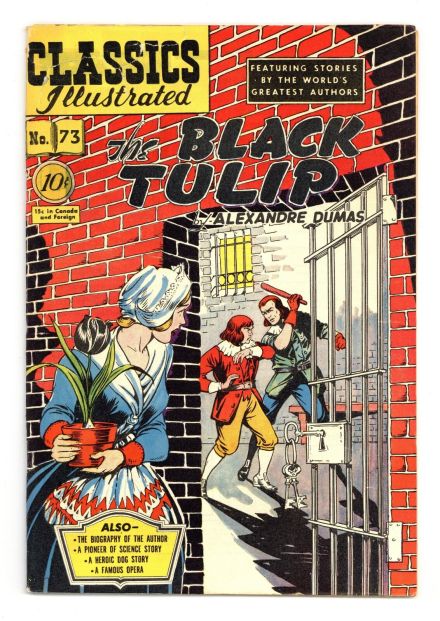Pam’s Pictorama Post: I continue my second part, tulip treatise today with an odd alignment that came out of tulip talk recently here at Deitch Studio. As occasionally occurs here over leisurely morning work, reading and discussion sessions, Kim and I meandered through both my tulip triumphs in New Jersey and his interest in this book and comic as outlined below and these posts were born. Welcome to The Black Tulip and part two of the Pictorama post.
****
I commence with a full admission that before I met Kim Classics Illustrated comics were at best known to me in a theoretical way – a sort of punchline to a joke about not having read a school book assignment – as in clearly they read the comic book version. I confess I have never actually read one to date.
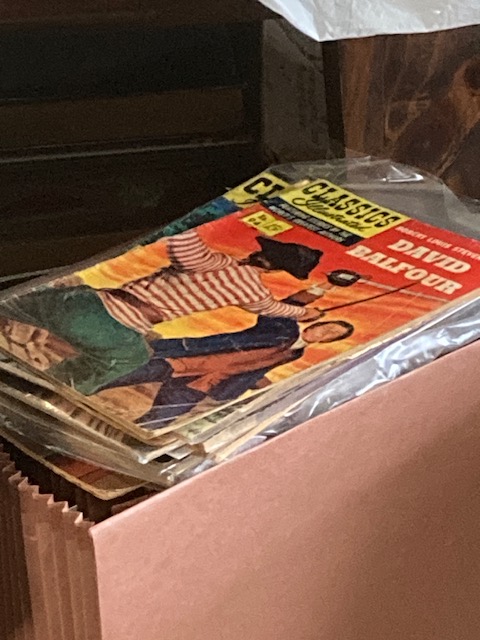
A number of years back Kim discovered a guy on 86th Street who was selling them. Not every day of the week, but most weekend days and maybe a few others piles of them on a table with their bright yellow logos being hawked. Over time they began their siren song and Kim was lured into slowly acquiring both those remembered from his youth and then ones he had missed along the way. Slowly his collection grew if haphazardly. I can’t remember now if the fellow gave up before Covid or it was the pandemic that did his periodic business in. And it wasn’t a constant flow, but an occasional addition would be made via eBay. Although he might give a quick look when I was with him it was generally a mission he completed on his own – an excuse for a walk on a nice day and presumably some comics chat.
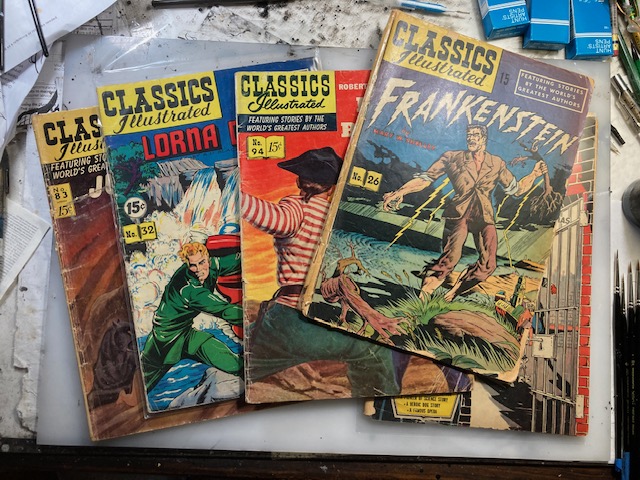
Kim, a voracious reader and particularly of classic literature, seems like an unlikely candidate however most recently he uses these as sort of massive supplemental illustrations to something he is reading. (The man is devoted to illustrated fiction in all its guises.) A large trade paperback on the history of Classics Illustrated found its way into the house recently and, although he is a committed Dumas fan, his purchase of The Black Tulip I believe was a result of his reading of that. The novel is on its way so he has not commenced reading it yet.
Classics Illustrated (which has lodged in my brain as Classic Comics) had a 30 year run, from 1941-1971, launching with The Three Musketeers. With printing and reprinting and the collecting of them, it can be a deep and largely affordable vein of comics collecting. If Kim were writing this there would be color and lore I cannot provide – thoughtful observations about the various artists who illustrated them, some who were wrapping up a career during the heyday of comics.
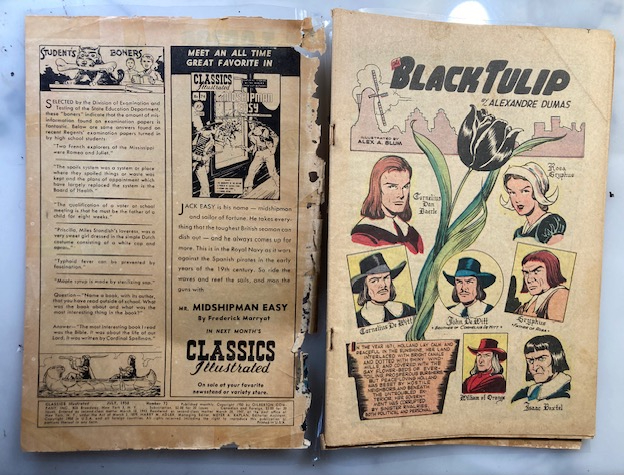
The Black Tulip (based as noted on the novel by Alexandre Dumas) was illustrated by Alex A. Blum (1889-1969) and I would say his illustrations are definitely part of the appeal of the comic. The story takes place during the tulip craze in the Netherlands of the 1600’s after the introduction of the plant from the near east in the preceding century. As you probably know, tulips were wildly sought after and the bulbs traded like gold or cocoa on a world exchange. Fortunes were made and lost in tulips and even poor and middle class families might stake their fortunes on the waxing and waning of them.

The plot of the novel is the race to develop a truly black tulip and the nefarious individuals who would do anything to capture a $100k guilder prize for the development of it. (For the record, a true black tulip does not exist even today and a very dark purple one called black is as close as one comes.) Since Kim is planning to read the original novel as well so I will have to ask him if they explain why black seemed so desirable – I prefer red and orange among others myself. (It should be noted that blue does not exist either – only a sort of lavender to blue.)
The jolly cover caught my imagination and a stroll through the comic is not disappointing. For the record, there is a column in the front cover called Student Boners which claims to be funny mistakes made on regional state exams – along the lines of Name two explorers of the Mississippi – answer: Romeo and Juliet. There is a bio of Dumas and encouragement to read the full novel at the back. Throughout there seems to be a layer of an in the service of sort of self-conscious educational mission.
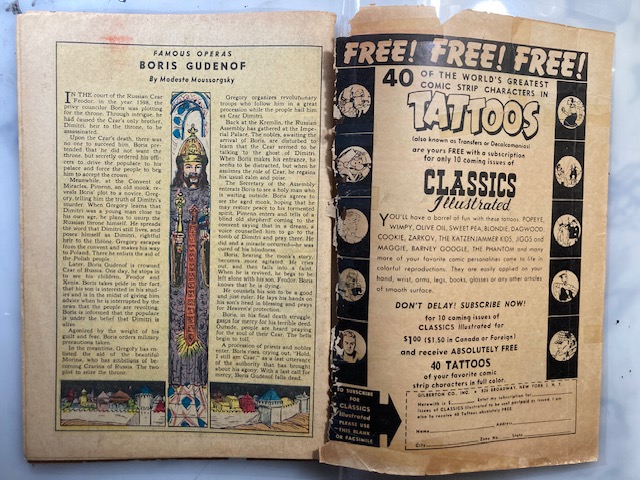
Along those lines also included at the back is a plot summary of the opera Boris Gudenof (what did kids make of that?); a bio of Alfred Nobel (Inventor of Dynamite!); and an unrelated short story about a dog. Kim informs me that the books had to be weighted with a certain amount of text in order to get a book rate for mailing. (This is part of the eventual undoing of the company as they ultimately lost this status.) There is an emphasis on the great literature these are based on (There have been no greater story-tellers than these immortal authors) and on reading in general.
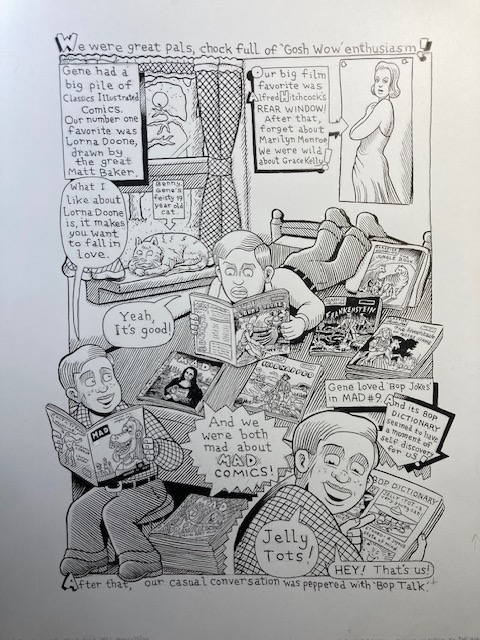
As I alluded to above, these comics were a fixture of Kim’s childhood and a recently completed page from an upcoming story for his next book shows a young Kim and a friend in a room littered with them. (We had some discussion over which covers would be featured.) As for me, well my generation had Cliff Notes (which also took a final bite out of these comics) instead. I never read them, but I am sure they were far less romantic and potentially interesting as Classics Illustrated and in addition I doubt that anyone collects them today.
